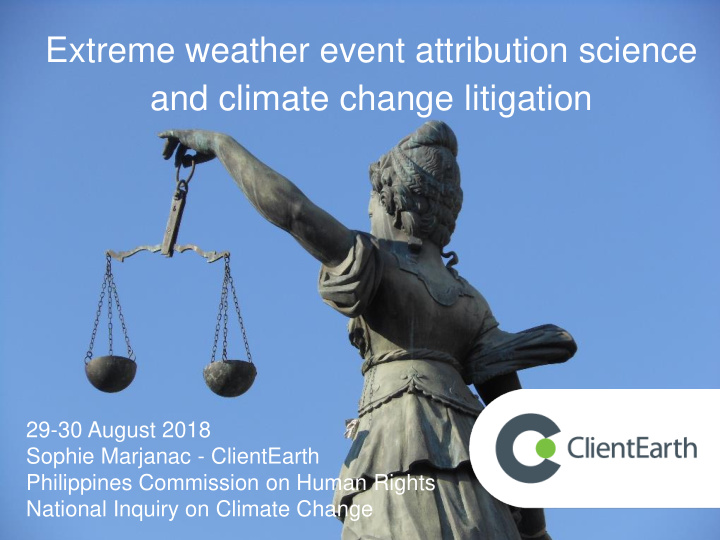



Extreme weather event attribution science and climate change litigation 29-30 August 2018 Sophie Marjanac - ClientEarth Philippines Commission on Human Rights National Inquiry on Climate Change
An introduction to ClientEarth • ClientEarth is a non-profit environmental law organisation • We use law, science and policy to tackle key environmental challenges • We have conducted legal research into climate change litigation around the world • We have also conducted research into the implications of climate-related financial risk for company reporting and directors’ duties
Event attribution science: Objectives • To understand what causes extreme weather events and how human greenhouse gas emissions change those events • To better understand the causes of extreme heat, rain, drought or storms caused by climate change • To respond to the public’s question ‘is this climate change?’, by answering the more scientifically correct question ‘how has climate change made this event stronger, or more likely to occur?’
Event attribution science: Methodology • Define the event and gather information relating to the event from observations • Compare the chance/strength of observations and modelled simulations of the ‘real world’ with models simulating the world without human greenhouse gas emissions (the ‘counterfactual world’) • Calculate a risk ratio, by comparing the chances of the event occurring in the ‘real world’ v ‘the counterfactual world’ Source: World Weather Attribution, Analysis of Euro-Mediterranean Heat Summer 2017 (https://wwa.climatecentral.org/)
Event attribution science: Peer review • Explaining Extreme Events from a Climate Perspective, Special Supplement to the Bulletin of the American Meteorological Society • National Academies of Sciences, Engineering, and Medicine, Attribution of Extreme Weather Events in the Context of Climate Change (The National Academies Press 2016)
Event attribution science: Results of some recent studies • Sept 2017 Hurricane Harvey, US: Heavy rainfall made approx. 3 times more likely, and 15 % more intense, although still a very rare event • 2015-17 Drought in Western Cape, SA: Chance of this rare event (1 in 100 year drought) has increased by a factor of 3.3. In a world with 2 degrees of warming, droughts like this will be 6 times more likely • July 2018 Heatwave in Northern Europe : Rare high temperatures across the region made at least 2 and up to 5 times more likely because of climate change (rapid study not yet peer reviewed)
Event attribution science: Relevance for law • Provides evidence of specific and quantifiable harm at the regional or sub-regional level • Evidence of improved foreseeability of strength and expected chance of certain events • Legal duty holders: • Governments including local authorities and contracted infrastructure providers (airports, roads, flood preparation); • Professionals (engineers, architects) often contracting to the above; and • Companies (eg heatwaves/storms affecting employees, assets and supply chains).
Economic impacts of climate change on economy and companies "The combination of the weight of scientific evidence and the dynamics of the financial system suggest that, in the fullness of time, climate change will threaten financial resilience and longer-term prosperity... Climate change is the Tragedy of the Horizon .” -- Mark Carney, Governor of the Bank of England, Speech to Lloyd’s of London, September 2015
Taxonomy of climate risk for companies • Climate related financial risks may arise for companies from: • Physical risks: As demonstrated by event attribution science, and predictive climate science; • Transition risks: corporate losses could arise if markets shift due to regulation or technological disruption; and • Litigation risks: Litigation arising from the above risks themselves, or from tort / compensation claims.
Task-force on Climate-related Financial Disclosures (TCFD) • Investor-led and seen as industry standard • Final Recommendations Report, suggests listed companies’ disclosures cover the following areas: • Governance: how the board manages climate risks and opportunities • Strategy: describes the impact of climate change on the company and its strategy • Risk management: Describe how the company manages climate risks; and • Metrics and Targets: includes data including on emissions and targets • Recommends a 2-degree scenario analysis
Directors’ duties • Duties require directors to act in best interests of their company, and with reasonable prudence, due diligence and skill. • In some jurisdictions (UK, Brazil, Canada), explicit requirement to consider stakeholder interests and to consider role as ‘good corporate citizen’ • It is not acceptable to fail to manage reasonably foreseeable material climate risks • Existing legal duties do not prevent company directors from considering human rights and environmental impacts in business decisions
Recommendations for effective human rights due diligence on climate change An effective human rights due diligence process in the context of climate change should: • Ensure that the company has a strong governance framework; • Make a commitment to reporting on climate-related risks in accordance with the TCFD recommendations; • Include a robust analysis (developed in consultation with stakeholders) of the company’s operations in 2-degree compliant scenario; and • Describe how the company will reduce emissions in line with well below 2-degree temperature goal, in order to respect human rights.
Thank You Sophie Marjanac Lawyer, Climate Programme smarjanac@clientearth.org @SMarjanacCE
Recommend
More recommend